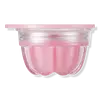What's inside
What's inside
 Key Ingredients
Key Ingredients

 Benefits
Benefits

 Concerns
Concerns

 Ingredients Side-by-side
Ingredients Side-by-side

Diisostearyl Malate
EmollientPolybutene
Hydrogenated Polyisobutene
EmollientTrimethylolpropane Triisostearate
EmollientPentaerythrityl Tetraisostearate
EmollientSilica Dimethyl Silylate
EmollientHydroxystearic Acid
CleansingPhenyl Trimethicone
Skin ConditioningEthylene/Propylene/Styrene Copolymer
Parfum
MaskingTocopheryl Acetate
AntioxidantBenzyl Benzoate
AntimicrobialDehydroacetic Acid
PreservativeLinalool
PerfumingButylene/Ethylene/Styrene Copolymer
Limonene
PerfumingHexyl Cinnamal
PerfumingPentaerythrityl Tetra-Di-T-Butyl Hydroxyhydrocinnamate
AntioxidantLitchi Chinensis Fruit Extract
Skin ConditioningWater
Skin ConditioningButylene Glycol
Humectant1,2-Hexanediol
Skin ConditioningDiisostearyl Malate, Polybutene, Hydrogenated Polyisobutene, Trimethylolpropane Triisostearate, Pentaerythrityl Tetraisostearate, Silica Dimethyl Silylate, Hydroxystearic Acid, Phenyl Trimethicone, Ethylene/Propylene/Styrene Copolymer, Parfum, Tocopheryl Acetate, Benzyl Benzoate, Dehydroacetic Acid, Linalool, Butylene/Ethylene/Styrene Copolymer, Limonene, Hexyl Cinnamal, Pentaerythrityl Tetra-Di-T-Butyl Hydroxyhydrocinnamate, Litchi Chinensis Fruit Extract, Water, Butylene Glycol, 1,2-Hexanediol
Triisostearyl Citrate
EmollientHydrogenated Polyisobutene
EmollientButyrospermum Parkii Butter
Skin ConditioningMicrocrystalline Wax
Emulsion StabilisingPunica Granatum Sterols
Skin ConditioningOctyldodecanol
EmollientPolyethylene
AbrasiveDisteardimonium Hectorite
StabilisingRicinus Communis Seed Oil
MaskingCocos Nucifera Oil
MaskingAloe Barbadensis Leaf Extract
EmollientPersea Gratissima Oil
Skin ConditioningPhytosterols
Skin ConditioningLinolenic Acid
CleansingLinoleic Acid
CleansingHydrogenated Castor Oil
EmollientLauryl PCA
HumectantSodium Hyaluronate
HumectantCaprylyl Glycol
EmollientOleic Acid
EmollientLecithin
EmollientHexylene Glycol
EmulsifyingPhenoxyethanol
PreservativeTetrahexyldecyl Ascorbate
AntioxidantTocopheryl Acetate
AntioxidantMica
Cosmetic ColorantCI 77891
Cosmetic ColorantCI 77491
Cosmetic ColorantCI 77492
Cosmetic ColorantCI 77499
Cosmetic ColorantCI 77163
Cosmetic ColorantCI 42090
Cosmetic ColorantCI 75470
Cosmetic ColorantCI 15850
Cosmetic ColorantCI 45380
Cosmetic ColorantCI 45410
Cosmetic ColorantCI 73360
Cosmetic ColorantCI 17200
Cosmetic ColorantCI 19140
Cosmetic ColorantCI 15985
Cosmetic ColorantTriisostearyl Citrate, Hydrogenated Polyisobutene, Butyrospermum Parkii Butter, Microcrystalline Wax, Punica Granatum Sterols, Octyldodecanol, Polyethylene, Disteardimonium Hectorite, Ricinus Communis Seed Oil, Cocos Nucifera Oil, Aloe Barbadensis Leaf Extract, Persea Gratissima Oil, Phytosterols, Linolenic Acid, Linoleic Acid, Hydrogenated Castor Oil, Lauryl PCA, Sodium Hyaluronate, Caprylyl Glycol, Oleic Acid, Lecithin, Hexylene Glycol, Phenoxyethanol, Tetrahexyldecyl Ascorbate, Tocopheryl Acetate, Mica, CI 77891, CI 77491, CI 77492, CI 77499, CI 77163, CI 42090, CI 75470, CI 15850, CI 45380, CI 45410, CI 73360, CI 17200, CI 19140, CI 15985
 Reviews
Reviews

Ingredients Explained
These ingredients are found in both products.
Ingredients higher up in an ingredient list are typically present in a larger amount.
Hydrogenated Polyisobutene is a synthetic polymer. Polymers are compounds with high molecular weight. Hydrogenated Polyisobutene is an emollient and texture enhancer.
In one study, Hydrogenated Polyisobutene showed better skin hydration levels than Caprylic/Capric Triglyceride. As an emollient, it helps keep your skin soft and hydrated by trapping moisture in.
Hydrogenated Polyisobutene is often used as a mineral oil replacement.
Learn more about Hydrogenated PolyisobuteneTocopheryl Acetate is AKA Vitamin E. It is an antioxidant and protects your skin from free radicals. Free radicals damage the skin by breaking down collagen.
One study found using Tocopheryl Acetate with Vitamin C decreased the number of sunburned cells.
Tocopheryl Acetate is commonly found in both skincare and dietary supplements.
Learn more about Tocopheryl Acetate